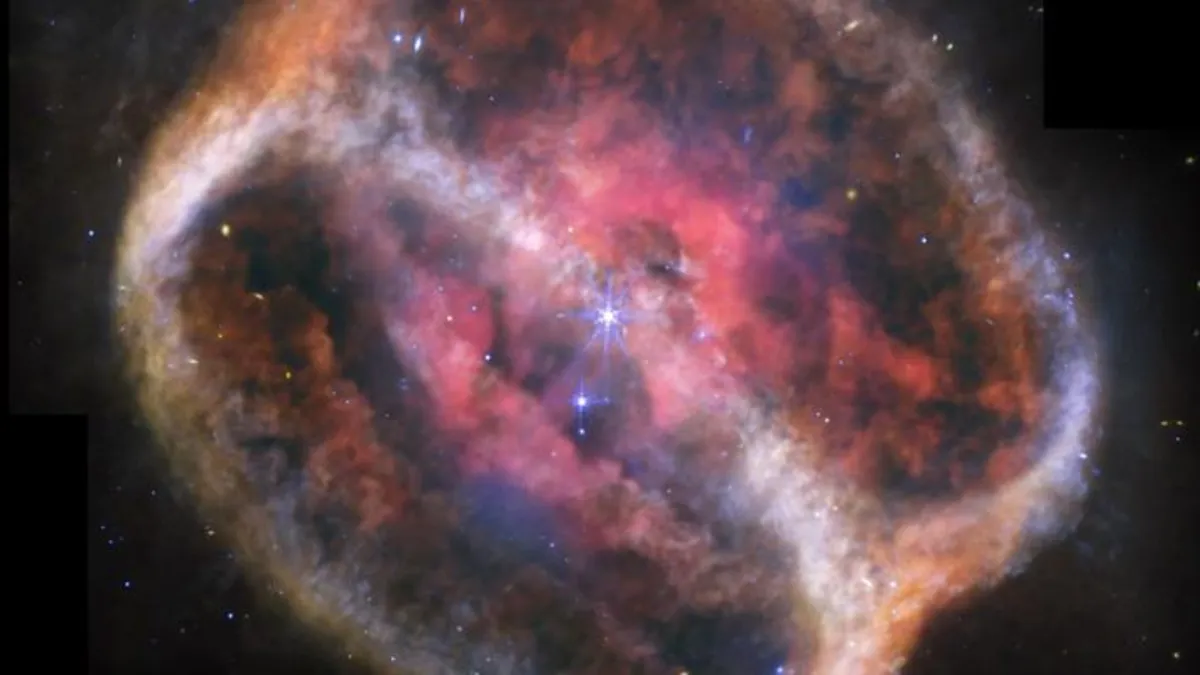
A breathtaking new image captured by the James Webb Space Telescope (JWST) is providing astronomers with unparalleled views of the complex and turbulent final stages in the life of a dying star. This remarkable snapshot features NGC 1514, a planetary nebula located approximately 1,500 light-years away from Earth in the constellation Taurus. Despite the name "planetary nebula," NGC 1514 has no connection to planets. Instead, it houses two stars at its core.
In the James Webb Space Telescope's observations, these two stars appear as a single point of light, surrounded by an arc of vibrant orange dust. Astronomers are particularly intrigued by the nebula's faint structure, reminiscent of a Venn diagram, which consists of two rings of ejected material shaped by the gravitational forces of the central stars. This discovery presents a unique opportunity to explore the intricate interactions of stellar outflows over astronomical timescales.
Mike Ressler, a project scientist for the JWST's MIRI instrument, emphasized the significance of this finding. "Before Webb, we weren't able to detect most of this material, let alone observe it so clearly," he stated. The data from MIRI enables scientists to thoroughly investigate the chaotic nature of this nebula.
Previous studies of this binary star system revealed that the nine-year orbit of these two stars is among the longest recorded for any planetary nebula. Astronomers believe that the formation of the nebula was predominantly influenced by the more massive of the two stars. As this star aged, it likely experienced significant expansion, shedding layers of gas and dust through its stellar wind and ultimately leaving behind a hot, compact core known as a white dwarf.
The winds from this white dwarf, which are faster yet weaker, probably swept up earlier, slower-moving material, resulting in the formation of clumpy, filamentary rings that are incredibly faint and only detectable in infrared light. This intriguing behavior has been made evident by the JWST's advanced capabilities.
In addition to the rings, the JWST's observations reveal a network of holes near the central stars, where faster-moving material has pierced through the slower, denser outer layers of ejected gas and dust. "When this star was at its peak of losing material, the companion star could have come exceptionally close," explained David Jones, a senior scientist at the Institute of Astrophysics on the Canary Islands. He confirmed the presence of a binary star system at the center of this planetary nebula in 2017. This interaction may have contributed to the formation of unexpected shapes, such as the observed rings.
The two rings, illuminated unevenly and showcasing distinct textures, are likely formed from very small dust grains that are gently heated by ultraviolet light emitted from the central white dwarf. Ressler elaborated, "When those grains are hit by ultraviolet light from the white dwarf star, they heat up just enough to be detected by Webb in mid-infrared light."
Interestingly, the JWST's observations also detected oxygen within the nebula's clumpy pink center, yet it notably lacked carbon and complex molecules like polycyclic aromatic hydrocarbons, which are typically found in such nebulae. This absence may be attributed to the long orbital period of the central binary stars, which could have agitated the expelled material and hindered the formation of these complex compounds.
The exquisite detail provided by the JWST’s observations has made the $10 billion telescope, NASA's largest and most powerful, increasingly sought after. Astronomers have requested the equivalent of nine years' worth of observing time within just one operational year. However, this heightened demand coincides with potential budget cuts of up to 20%, despite the mission being only halfway through its primary phase. These cuts, expected to be implemented later this year, could significantly impact all facets of the observatory's operations, including proposal reviews, data analysis, and community outreach.
Tom Brown, who leads the JWST mission office at the Space Telescope Science Institute in Maryland, expressed concerns during a town hall event at the annual American Astronomical Society conference, stating, "It's extremely worrisome that, while we're in the middle of the prime mission, we're also facing the possibility of significant budget cuts."